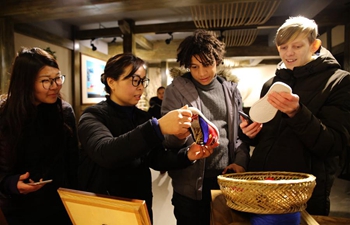WASHINGTON, Jan. 30 (Xinhua) -- An American study has revealed how a small part of the brain single-handedly steadies the body if it is thrown off balance.
The study, published Tuesday in Cell Reports, found that a brain region in mice called the lateral vestibular nucleus, or LVN, accomplishes this feat by moving muscles in a two-step, kneejerk response that first widens the animal's center of gravity, and then strengthens and stabilizes its limb muscles and joints.
These findings provide evidence that the LVN is the key to animals' ability to maintain balance, and show the mechanics of how animals stay upright when unexpected changes occur beneath their feet.
"We can all recall times when we've nearly lost our balance -- only to be saved by some quick reflexes," said Thomas M. Jessell, co-director of Columbia University's Mortimer B. Zuckerman Mind Brain Behavior Institute and the paper's senior author.
"Today's findings in mice suggest that reflexes like these may be driven by a predictable process guided by the LVN, a brain region that appears to be dedicated to one thing: keeping the body on its feet."
The researchers first trained mice to walk across a balance beam, while the beam was nudged at specific intervals.
After being momentarily thrown off balance, the mice almost always steadied themselves and continued on their way. Throughout this activity, researchers monitored muscle activity in the animals' limbs.
"Every time we nudged the beam, we observed a predictable pattern of muscle activity that helped the mice to regain their balance," said Andrew Murray, the paper's first author.
It shows that the pattern consisted of two movements in sequence: first, the mouse extended its paw, which widened the animal's base of support and second, the muscles around the animal's limb joints become strong and rigid, which helped the mouse propel itself back over the center of the balance beam.
In a second set of experiments, the researchers sought to identify how the animals' brains made all this possible. By using advanced molecular tools, they traced which brain region directed these specific movements. The data pointed to a tiny region in the brain called the LVN.
To confirm that the LVN was indeed responsible for maintaining balance, the researchers then silenced it. When the scientists again nudged the beam, this time they could not steady themselves.
A preliminary research in mice has shown that the LVN appears to perk up when the animal begins walking on something unsteady, such as a balance beam. But when it is walking on a more stable surface, such as a treadmill, it remains dormant.

















